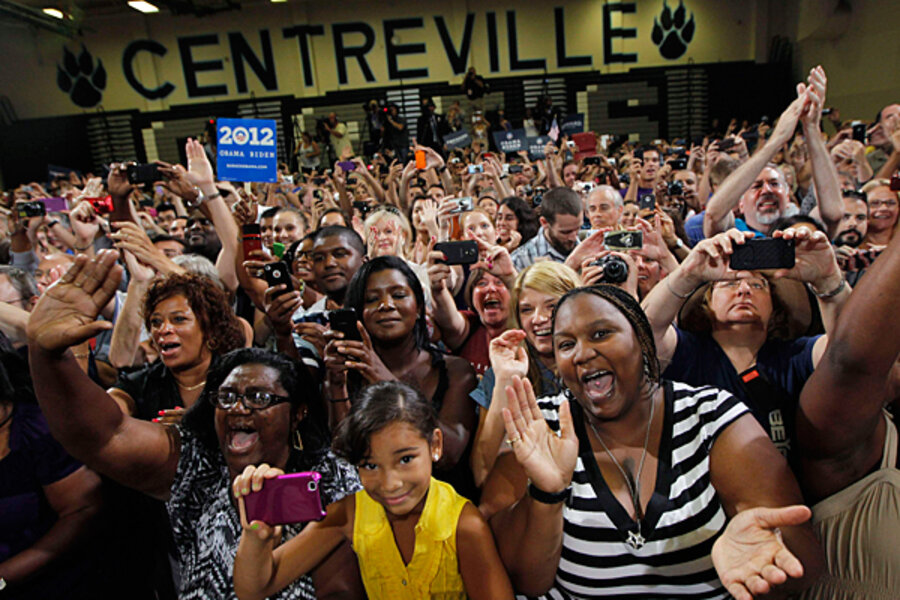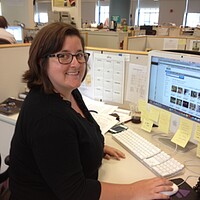Poll: Americans favor Obama over Romney for strengthening public schools
Loading...
Americans overall say President Obama is the presidential candidate who will do more to strengthen public education, but independent voters have more confidence in Mitt Romney for that job.
This is a key finding in a poll measuring public opinion on America’s state of education, which was released Wednesday by Phi Delta Kappa (PDK) and Gallup.
Specifically, 49 percent of Americans overall prefer Mr. Obama for strengthening public education, while 44 percent overall favor Mr. Romney. But the percentage siding with Romney goes up to 46 percent when only independent voters are considered, while Obama slips to 41 percent.
Romney’s support from independent voters is probably related to Massachusetts’ education standards shifting from medium- to high-achieving during his tenure as governor, says Chester Finn Jr., president of the Thomas B. Fordham Institute in Washington. Mr. Finn participated in a conference call with reporters Tuesday to comment on PDK/Gallup’s 44th annual Poll on the Public’s Attitudes Toward the Public Schools.
“His track record of accomplishment may make a difference in public perception of Romney,” says Mr. Finn.
Finn says he is disappointed by another finding in the poll: Respondents were reluctant to provide free public education, school lunches, and other benefits to children of illegal immigrants. Fifty-eight percent of Americans oppose this, although opposition is down from 67 percent in 1995. Opinion is split down party lines, with 65 percent of Democrats but only 21 percent of Republicans in favor.
“It is our responsibility to educate every child who is here, no matter how they got here,” says Finn.
The public is also split, the study found, on what measures should be used to evaluate teachers.
Fifty-two percent said they are in favor of states requiring that students’ standardized test results be used in teacher evaluations, and 40 percent of adults said that one-third to two-thirds of a teacher’s evaluation should be based on how well students perform on standardized tests.
Lily Eskelsen, who is vice president of the National Education Association and also participated in the conference call, opposes this approach. It’s important that teachers unions talk with administrators about teacher evaluations and how to improve them, she says.
She gave an example from Helena, Mont., where teachers developed their own criteria, based on course subjects, to measure student progress. The criteria had to be approved by a committee of peers and administrators. Parents agreed with the system, Ms. Eskelsen says.
“The public wants children and educators to be held to high standards,” she says. “There is a common core of what kids should know and be able to do,” and there are multiple measures for evaluating those skills.
Despite division over how to evaluate teachers, 70 percent of respondents said that they trust and have confidence in public-school teachers. Fifty-seven percent said teachers need more rigorous training, and 3 out of 4 people said that requirements for teacher training programs should be as rigorous as engineering, business, pre-law, and pre-medicine programs.
Respondents also found common ground in identifying the biggest problem facing their local schools: lack of funding.
Thirty-five percent of all respondents, and 43 percent of parents, reported a lack of funding as the biggest problem confronting local schools in the United States. That’s a significant shift from 10 years ago, when discipline issues were the biggest concerns related to public education.
“All Americans are aware of the impact that the financial crisis is having on public education,” said William Bushaw, executive director of PDK International and co-director of the PDK/Gallup poll, during the conference call.
Even so, 60 percent of respondents also said that balancing the federal budget is more important than improving the quality of education. This schism, Mr. Bushaw says, reflects differing viewpoints on national versus local spending priorities.
Improving the nation’s urban schools was almost unanimously important to respondents, with 97 percent saying that it is a priority. Sixty-two percent said that they’d be willing to pay more in taxes to help these schools. Closing the achievement gap between white and black and Hispanic students was important to 89 percent of respondents, and 84 percent of people think this can be done while maintaining high standards for all children.
For the first time, the study found declining support for charter schools, down to 66 percent from 70 percent last year. Republicans are more supportive of charter schools, with 80 percent in favor compared with 54 percent of Democrats.
On the other hand, support for private school vouchers jumped from 34 percent last year – its lowest level – to 44 percent this year.
The PDK/Gallup poll interviewed a random sample of 1,002 adults in May and June. Sixty-seven percent of the respondents did not have children in public schools, while 27 percent were public-school parents, and 4 percent were nonpublic-school parents.








